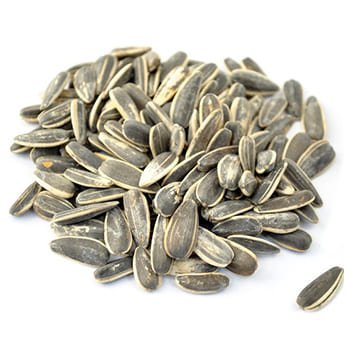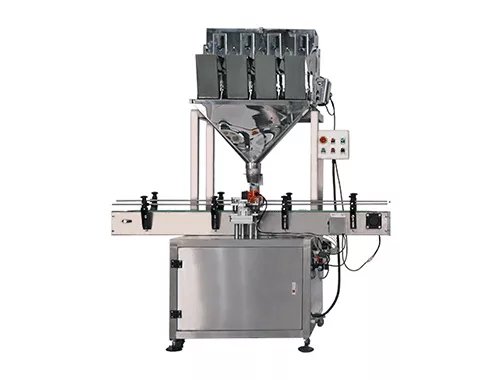What is a linear weigher?

It is an automatic weighing machine that consists of several key components, including storage hopper, vibrating feeder lane, and weigh bucket. These components work together to provide accurate measurements of granular, powdered, or free-flowing products.
How does linear weighing machine work?
Vibrating feeder lanes feed products from storage bucket to weigh buckets, the weigh bucekets which are connected with loadcell weigh the weight as preset parameter. While the weight of weigh bucket reaches 80% of desired weight, the vibrating feeder lanes will lower down the vibration, lower down the feeding speed for high accuracy weight.
What are the linear weighing machine application?
Linear weighing machine scales are commonly used in various industries for small sizes products, such as seeds, rice, granular powders, small snacks, berries, small pet food and so on.




What are the common models of linear scale?

Here is the worksheet and datasheet of our 1 to 4 heads linear weighing machine.
| Model | SP-LW1 | SP-LW2 | SP-LW3 | SP-LW4 |
| Weight Range | 50-1500g | 50-2500g | 50-1800g | 20-2000g |
| Hopper Volume | 1.6L/3L/5L | 3L/5L | 3L | 3L |
| Speed | 10 bpm | 20 bpm | 30 bpm | 40 bpm |
| Accuracy | ±0.2-3.0 g | ±0.5-3.0 g | ±0.2-3.0 g | ±0.2-3.0 g |
| Power Supply | 220V, 50HZ/60HZ | 220V, 50HZ/60HZ | 220V, 50HZ/60HZ | 220V, 50HZ/60HZ |
While linear scales equip with manual sealing machine, a foot pedal is needed for controlling product filling. Moreover, they can be equipped with various automatic packaging machines, such as vertical form fill seal machine, premade pouch packing machine, can filling line and etc.


What are the advantages of linear weighing machine?
- Modular linear weigher designed for precision weighing and lower maintenace cost.
- Flexible to operate with different kinds of automatic packaging machine, replace the hand-bag weighing and packing. Low cost implementation of an automated packing process.
- It is possible to mix while weighing.
- Construction and parts made of stainless steel 304 fulfill hygiene standards.
How to choose the right linear weighers?
Assess Your Specific Needs: Determine the types of products you will be packaging, the required speed, and the level of accuracy needed for your operations.
Consider Technical Specifications: Examine factors such as hopper capacity, weighing range, and speed capabilities when selecting a linear weigher. Make sure the chosen model meets your operational requirements. Surely the most efficient way is talk with our sales team, our team will offer you best solutions!
Compare Models and Manufacturers: Research various linear weigher models and their manufacturers to find the best fit for your needs. Look for reputable companies with good customer reviews and reliable support.
Linear weighing machine installation guide
Setting up your linear weigher correctly is essential for optimal performance:
1. Choose the Right Location
Select a location with adequate space for installation and operation, and ensure it is free of environmental factors that could affect weighing accuracy, such as vibrations or air currents.
2. Proper Assembly and Installation
Follow the manufacturer’s guidelines for assembly and installation , making sure all components are secure and properly connected.
3. Calibration and Testing
Calibrate your linear weigher according to the manufacturer’s instructions and perform tests to ensure accurate weighing and smooth operation before using it in your packaging line.
What are the Tips For Linear Scale Operation and Optimization?
Proper Product Feeding: Ensure the product is fed into the weigher consistently and without clumping or bridging to avoid weighing inaccuracies.
Adjust Settings for Different Products: When changing products, adjust the machine settings accordingly to maintain accuracy and efficiency.
Maximize Efficiency: Monitor the performance of your linear weigher and make adjustments as needed to optimize weighing speed and accuracy.
What are the common Maintenance and Troubleshooting?
Keep your linear weigher in top condition with regular maintenance:
Routine Cleaning and Maintenance: Clean your linear weigher regularly to prevent product buildup and ensure optimal performance. Perform routine maintenance according to the manufacturer’s guidelines.
Identify Common Issues: Familiarize yourself with common issues that may affect your linear weigher’s performance, such as incorrect calibration, worn parts, or electrical issues.
Seek Professional Help When Needed: If you’re unable to resolve an issue on your own, consult with a professional technician or the manufacturer for assistance.
Conclusion
Linear weigher is one of important machines in weighing system, and it plays a critical role in the packaging industry, providing fast and accurate weighing solutions for a wide range of products. By understanding the benefits, selecting the right model, and following best practices for installation, operation, and maintenance, you can ensure your linear weigher performs at its best. Keep up with industry standards and compliance to maintain the quality and efficiency of your packaging process.
